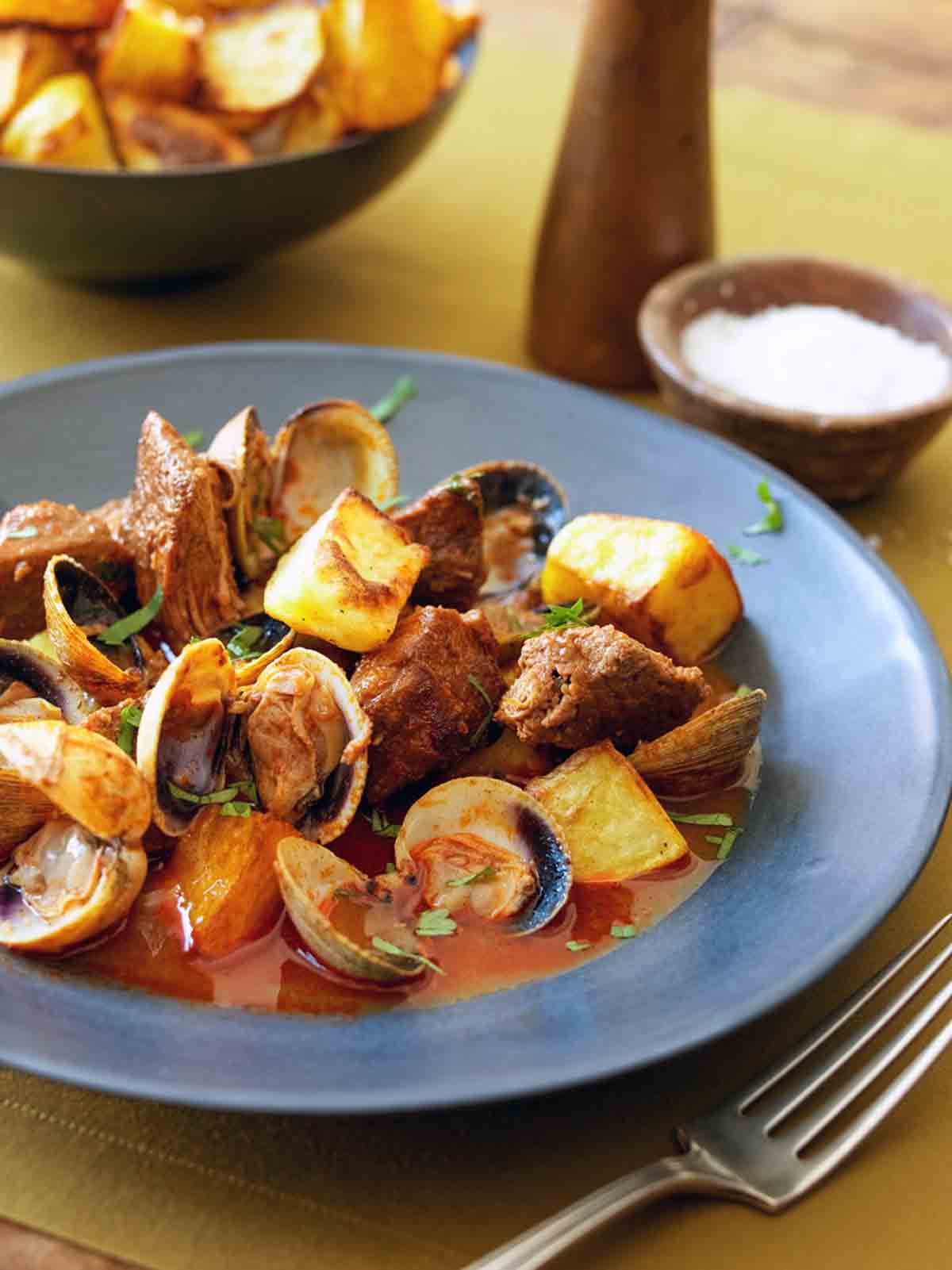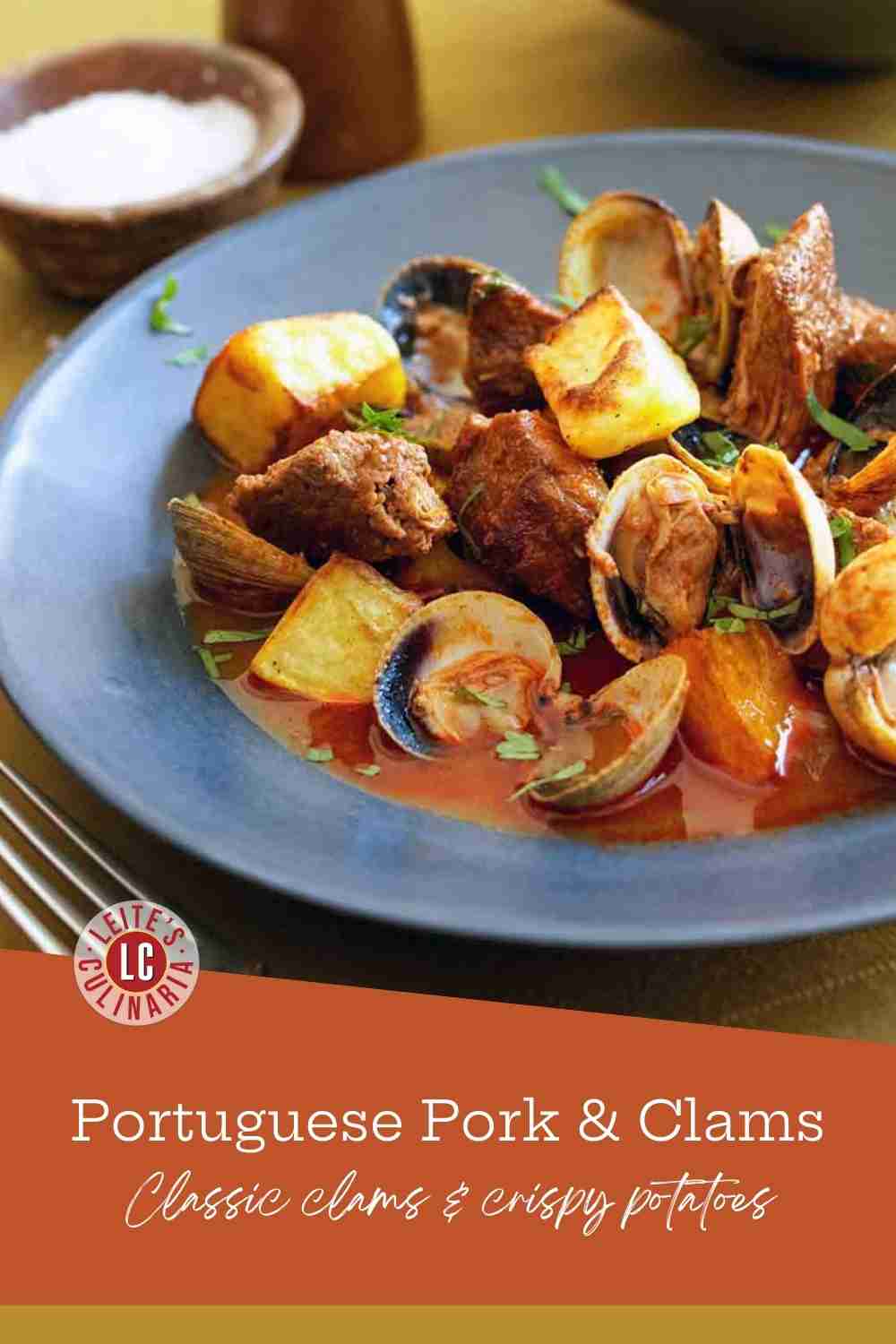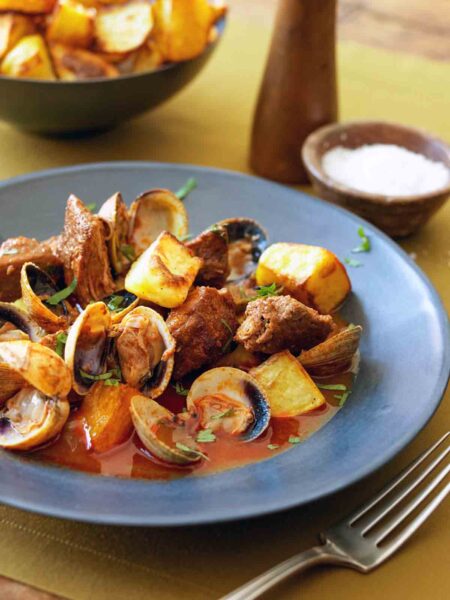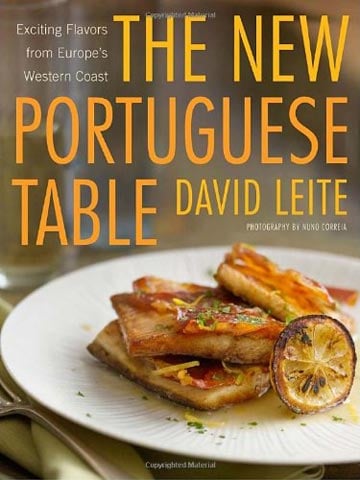
TL;DR (Quick-Answer Box)
- What it is: A traditional Portuguese surf-and-turf of tender braised pork shoulder, briny clams, and crispy potatoes in a savory white wine and red pepper sauce.
- Why you’ll love it: It’s the ultimate comfort food—boldly flavorful, soul-satisfying, and surprisingly easy to master. Perfect for impressing guests or a special Sunday family dinner.
- How to make it: Marinate pork in pepper paste and wine overnight, then sear and braise until tender. Roast potatoes separately and steam clams in the pot until they pop.

Jump To
Portuguese pork and clams, or Porco à Alentejana, is one of Portugal’s most iconic dishes, a surf-and-turf combination that brings together tender pork and briny clams in a rich, garlicky sauce. Despite its name—which translates to “Alentejo-style pork”—the dish likely originated in the Algarve, where seafood rules.
But the name is no accident. It’s a nod to the Alentejo‘s prized black Iberian pigs (porco preto), which feast on acorns and produce some of the most flavorful, well-marbled pork in the world.
In Portugal, the traditional recipe calls for chunks of pork fried in lard, then tossed with clams, crispy fried potatoes, and pickled vegetables. It’s a deeply savory, rustic dish and utterly perfect—in Portugal.
Recreating it here in the States took some adjustments. American pork is much leaner, thanks to decades of breeding (hence the marketing campaign as “The Other White Meat”), which can make the dish less forgiving if not handled carefully.
To get that same rich tenderness, I swapped the usual pork loin for pork shoulder (aka pork butt), which has more marbling and holds up beautifully to slow cooking. Instead of a quick fry in lard, I marinate it overnight and braise it, ensuring juicy, flavor-packed pork.
And then there’s the deep-frying dilemma. Traditional Portuguese pork and clams recipes call for crispy fried potatoes. But since folks cringe at the idea of deep-frying, I oven-roast them instead, getting that golden, crispy exterior without the extra hassle.
The result? All the bold, familiar flavors of the Portuguese classic, adapted for the way we cook today—without sacrificing what makes it great.
Chow,

Pork and Clams FAQs
I don’t recommend it. The lean cuts of pork will be tough and chewy after the braise. Stick with pork shoulder or butt here.
Always look for clams with closed shells when buying live, and always buy from a licensed and reputable supplier. Fresh clams (and other shellfish, for that matter) should have a “Harvested in the USA” label, and the supplier/fishmonger should be able to tell you exactly when and where they were harvested.
You may notice that there’s a bit of dirt and sand on your clams. No worries at all, the muck around it actually helps keep the clam moist until you’re ready to use them. Just soak the clams and give them a good brush before cooking.
Generally speaking, a clam that doesn’t open is probably dead. While you could still eat it, don’t. You don’t know why it died (and there are lots of reasons…none of them good) before you got your hands on it, so don’t tempt fate.
This also goes for open clams that don’t close when you tap them on the counter before cooking. As well, some clams are just so tightly joined to the shell that they’re not going to open—they’re alive but tough enough that you wouldn’t want to eat it anyway. Stubborn bast*rds!

Portuguese Pork and Clams | Porco à Alentejana
Ingredients
- 3 pounds boneless pork shoulder or butt, cut into 1-inch (2.5-cm) chunks
- 1/4 cup red pepper paste
- 1 3/4 cups dry white wine
- 6 tablespoons olive oil, plus more if needed
- 2 medium yellow onions, coarsely choppped
- 3 cloves garlic, minced
- 2 pounds Yukon gold potatoes, peeled and cut into 1-inch (2.5-cm) cubes
- Kosher salt and freshly ground black pepper
- 3 1/4 pounds small clams, such as cockles, manila, butter, or littlenecks, scrubbed and rinsed
- 1/4 cup chopped fresh cilantro leaves
Instructions
- In a medium bowl, toss the pork chunks with the red pepper paste. Add the wine and toss again. Cover with plastic wrap and refrigerate for at least 24 hours or up to 36 hours.
- Position a rack in the middle of the oven and crank up the heat to 400°F (200°C).
- In a colander set over a large bowl, drain the pork, reserving the marinade. Pat the pork dry with paper towels.
- In a large pot over medium-high heat, warm 3 tablespoons olive oil. Working in batches, add the pork and cook, stirring occasionally, until browned on all sides, 5 to 7 minutes. Add more oil in between batches, if needed. Transfer the pieces to a plate using a slotted spoon. If the bottom of the pot develops a dark coating, tip in some water in between batches and scrape it up.
- Lower the heat to medium, add the onion, and cook until soft, about 5 minutes. Add the garlic and cook for 1 minute more.
- Pour in the reserved marinade, return the pork to the pot, and cook, covered, over low heat until the meat is tender, 1 to 1 1/2 hours. If it looks as if the liquid will burble away, spoon in a bit of water.
- Meanwhile, in a large bowl, toss the potato cubes with the remaining 3 tablespoons oil, season lightly with salt and with plenty of pepper, and scatter in one layer on a rimmed foil-lined baking sheet. Roast, flipping them once or twice, until golden brown, about 45 minutes.
- Discard any clams that feel heavy (which means they’re full of sand), have broken shells, or don’t close when tapped.
- Raise the heat under the pork to high, stir in the clams, cover, and cook until they open, 7 to 10 minutes. Toss out any that refuse to pop open. Taste the broth and season with salt and pepper if needed.
- To serve, remove half the clams from their shells, and return them to the pot. Toss out the shells. Line the bottom of the serving bowls with the potato cubes, top with the pork and clams and broth, and sprinkle with the cilantro. Have a large bowl at the ready for the shells.

Explore More with AI
Nutrition
Nutrition information is automatically calculated, so should only be used as an approximation.
Recipe Testers’ Reviews
This hearty meal was so satisfying and comforting, and our whole family loved it. The pork was meltingly tender, and the clams gave a pleasant brininess to the spicy broth. Even my kids were fighting over the last clam in the pot. It was an enjoyable weekend project and well worth the effort.
I used inexpensive Pinot Grigio and Manila clams. I didn’t need to add any additional oil between batches of meat or any water while searing or braising the meat.











I have made this for many a weekend/dinner guest to oohhhs and ahhhs. Since I found your website some years ago. Always everyone thinking ai worked my intro the bone. Shame on me for allowing them to believe it. But I’m wondering if some saffron wouldn’t kick things up a notch?
Thank you.
Lisa, I’m so delighted to hear! (And your secret’s safe with me.) I think saffron, which is a delicate spice, would get lost in this. The pepper paste is a bold, flavor-forward ingrient. I say save that “liquid gold” for dishes where ot van shine, such as risotto Milanese.
David the recipe sounds great and wanting to try soon with so many favourable comments. I think I may only be able to get frozen clams locally so how would I go about using these? Defrost first etc?
Hey, you sure can use frozen clams. What do you want to do is let them defrost completely, pat them dry, then add them to the recipe. Are your clams frozen in the shell or not?
Thanks, David. Yes they be in the shell.
Excellent, Andy. You’ll be fine. I look forward to hear how it turns out.